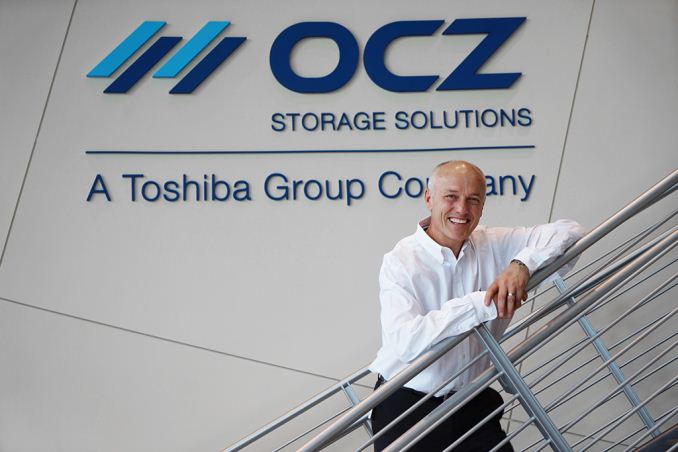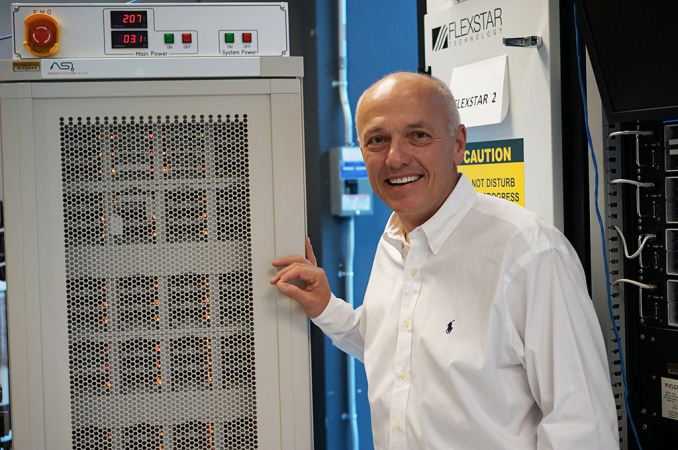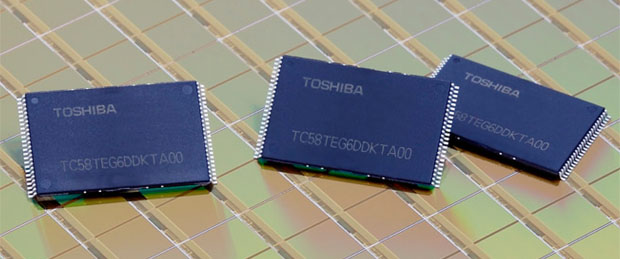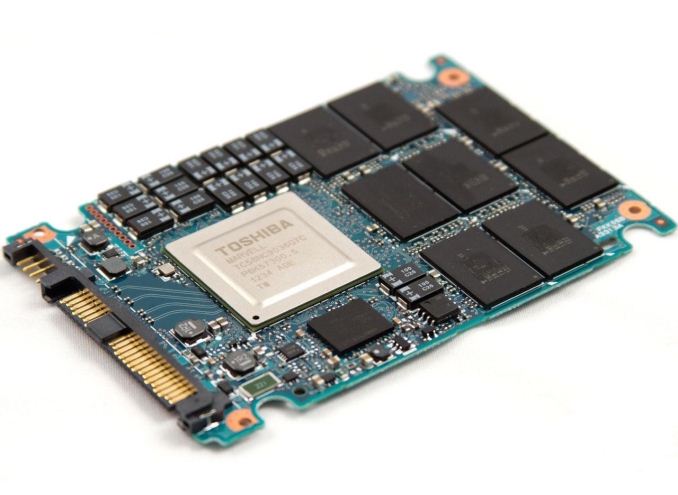Interview with OCZ's CEO Ralph Schmitt: The New Tides of OCZ
by Kristian Vättö on January 27, 2015 3:02 PM EST
At CES I had the opportunity to sit down with Ralph Schmitt, OCZ's CEO, for a good hour to discuss the state of the company. Before we get to the actual interview, let me introduce Mr. Schmitt. Mr. Schmitt has been OCZ's CEO since October 2012, and prior to that he was actually an OCZ board member while he was the President and CEO of PLX Technology. Mr. Schmitt has had an honorable career in addition to OCZ and PLX Technology, as he has served in several CEO and high-level executive roles in various semiconductor companies such as Cypress and Sipex. Academically, Mr. Schmitt holds a B.S. of Electrical Engineering from Rutgers University.
Discussing OCZ's History & Background in Brief
OCZ has gone through a lot in the past couple of years. In November 2013 OCZ filed for bankruptcy, and shortly after Toshiba announced that it will be acquiring OCZ's assets for $35 million. Since then OCZ has been operating as an independent subsidiary under Toshiba. Unlike what usually happens after acquisitions, OCZ has not been integrated to Toshiba's existing units and all of OCZ's different units (such as marketing, product development etc.) have remained in tact (for what it's worth, I'm still working with the same people as I was before the acquisition). The OCZ-Toshiba relationship resembles more like a strategic partnership to be honest as that indicates how separate the two are, but only in a good way.
The reason why Toshiba wanted to keep OCZ independent was to ensure that the company's talent doesn't get buried into Toshiba's massive organization. The common issue in acquisitions is that the acquiring company may not be able to use all the talent and resources of the acquired company because the culture of each organization can differ. In the end, individual talent isn't just something concrete and absolute like money that can easily be transferred from one place to another -- there are various environmental and cultural factors that go into it. For example, a change from liberal and relaxed culture to more tightly managed one can suppress some individuals because the way they work has to change, and the new way may not suit them. It is always a major challenge to integrate two companies with different organization cultures, so keeping the two separate is not always a bad idea.
Mr. Schmitt checking testing facilities
One element of the equation for OCZ is due to some management changes in September 2012 when Ryan Petersen, the founder and CEO at that time, resigned. However, companies are very much like cargo ships: once you get them moving to a specific direction, it won't be easy to change that, or at least it will take time and effort to do so. Even if you know that you are on your way to run aground, it may be too late to change the course and some negative results happen.
That's essentially what happened with OCZ. Even though Mr. Schmitt stepped in as the CEO only a month after Mr. Petersen had left and started to change the course of the company for the better (less products, more emphasis on development and validation), it was too late. There was financial trouble and they had to rely on borrowed capital to keep the company running, which came in at a high cost given that their credit rating was not a top grade. So while OCZ had been heading towards the right direction for a year, the company ran out of capital in late November 2013.
Fortunately, Toshiba saw eye-to-eye with OCZ's new path and Mr. Schmitt just wasn't given enough time and resources to fulfill the potential. As a result, Toshiba decided to let OCZ continue its business and R&D as a separate unit by providing financial support for the company. The new OCZ had, and still has, a sustainable business plan, so there was no reason to break up the company into pieces.
The Symbiotic Partnership
Mr Schmitt explained how the partnership between OCZ and Toshiba extends far beyond financial support. As part of the Toshiba Group, OCZ is now able to leverage a number of Toshiba’s labs and run much more extensive testing throughout the design cycle, as well as do more specialized testing and validation to meet specific customer requirements. During the baby steps of the acquisition, the companies had a few different philosophies when it came to validation, which makes sense given the different backgrounds. For instance, Toshiba might focus more on the NAND during testing/validation (Toshiba is the inventor and major supplier of NAND, after all), whereas OCZ would focus on other aspects they could impact like the controller and firmware first.
The companies have then aligned their philosophies to use the same thinking during product development and testing. Toshiba holds OCZ drives to the same quality standards as its own and OCZ has adopted many of Toshiba's processes for its quality control. The testing/validation aspect is just one example of how the two companies are supplementing each other. The key here is that both companies have and are still learning from each other to ensure that both companies are putting out the best possible products.
The simple, yet so complicated NAND
The one major advantage OCZ has gained is access to Toshiba's NAND knowhow. At the high level NAND is a fairly simple semiconductor (you apply a high voltage that creates an electric field that forces electrons to tunnel from the channel through the silicon oxide to the floating gate), but once you get down to the atomic level it becomes a highly complex piece of technology. Some of OCZ's engineers have been living in Japan since the acquisition and just learning things about NAND and its characteristics to help build better products. In this case, especially endurance tweaks that require a very deep understanding of NAND, so having access to that knowledge and applying it to product design will provide OCZ with a very important advantage in the market.
Another crucial element that Toshiba provides is the access to its NAND supply. In the past OCZ had to source NAND from the open market, which resulted in varying quality NAND being used. Like many components (and goods/stocks in general), NAND is sold on spot market where anyone can sell or buy NAND. In case a NAND manufacturer (or any company) has excess stock, they can dump a portion of that into the spot market and sell it at the day's price. It is possible to buy NAND straight from the manufacturer, but the required volume tends to be fairly high and in turn you don't get the benefits of the dynamic spot market (predicting supply/demand and the associated price changes can be very profitable, if successful).
Since OCZ sourced most of its NAND from the spot market, the quality wasn't always top notch. Especially during times of low supply, OCZ basically had to use any and all NAND it got its hands into. As NAND is such a vital element of an SSD, the lower quality NAND also had an impact on overall quality and in worst cases on customer satisfaction as well.
Now that OCZ has access to Toshiba's NAND, that is no longer a concern. Not only is OCZ getting a steady supply of NAND from Toshiba, it also has access to the latest and highest quality chips. It is not a secret that all NAND manufacturers cherry-pick NAND and use the best dies for their own drives, which is why the best quality chips don't even end up on the open market.
Toshiba SAS SSD
The companies have also gone through the process of unifying product roadmaps. Initially, there was quite a bit of overlap because both had their own lineups and tried to cover as much of the market as possible, but by mid-2015 there should no longer be any major product overlaps. For instance, OCZ has stopped all SAS development as Toshiba has more expertise in that field and the same goes for certain OEM drives where Toshiba has always had a strong presence. At the same time, Toshiba will let OCZ handle the OCZ branded retail sales and on the enterprise side OCZ's focus will be in SATA and PCIe drives. The idea and goal is to supplement each other's lineup, not to compete.
Aside from high-level roadmap comparison, there is cooperation in individual products too. For a TLC NAND based SSD, the companies decided that it's better to let Toshiba handle the development of that drive because the company has been developing one for quite some time now and building a competitive TLC SSD requires a hefty amount of NAND knowledge, which is Toshiba's area of strength. It simply makes sense to focus all resources on one platform instead of having OCZ and Toshiba both spend money on a design that ultimately has the same end goal. However, for the first time, the Toshiba-built TLC drive will also retail under OCZ brand, which makes sense as OCZ already has a widespread distribution network and the required support for retail sales. On the other hand, Toshiba is very interested in OCZ's upcoming JetExpress controller, so I wouldn't be surprised to see Toshiba branded SSDs with the JetExpress controller for OEMs.
Answering My Concerns
In addition to talking about the Toshiba relationship and direction of the company, we also discussed some of the criticism I have had over the past year on the product side. While OCZ has done a good job of cleaning its product portfolio from redundant elements, I'm still of the opinion that there is some redundancy and unnecessary overlap. The case in point is the overlap between Barefoot 3 based drives because right now OCZ is selling four different drives: ARC 100, Vertex 460, Vertex 460A and Vector 150 (although the Vertex 460A will be replacing the 460 as it's just a change to A19nm NAND). That increases to five if you count the AMD branded R7. In any case, there is three OCZ branded Barefoot 3 drives and out of these three the ARC 100 and Vertex 460(A) are very much alike. In terms of performance the difference between the two is marginal and feature wise the Vertex 460 adds Acronis' cloning software and a 3.5" desktop bracket.
I have been bugging OCZ about the similarity of the two for a while now and saying that it just adds unwanted clutter to the lineup. During the meeting, Mr. Schmitt shared that OCZ decided to keep the Vertex 460 lineup around because it's very popular in certain regions (e.g. countries within EMEA and Eastern Europe) because of the Vertex brand that has been around for so long (remember, not all buyers are as well educated as our readers). On the other hand, OCZ didn't want to "downgrade" the Vertex brand to become a value brand and decided to create a new ARC series for that purpose.
After hearing the explanation, it all makes more sense now. I can't say I am vouching for the existence of the Vertex 460(A) as from a reviewer's point of view it adds little to no value to the end user over the ARC 100, but from the business perspective I can understand why OCZ was so keen on keeping the lineup around even at the cost of fragmentation and clutter.
The Software Side of OCZ
Last but not least, for the past months OCZ has been working on an updated SSD toolbox. OCZ has offered a toolbox for its SSDs for years now, but the user interface has been rather awkward and the features lacking compared to what the competitors have. The new toolbox software is set to be released in the next couple of months and it will carry a refreshed, more user friendly UI along with the fairly common set of features (manual TRIM, over-provisioning, etc.).
It's a no-brainer move in my opinion because the importance of software has been on an increase lately. SATA 6Gbps has put a limit on performance differentiation (although PCIe will reopen those doors), so consumers have started to look for additional features and value, which software is an essential part of.
Final Words
The OCZ of today is very different from yesterday's OCZ. The management has changed the course to a sustainable path where focus is on long-term development and proper validation. The Toshiba partnership just further emphasizes the quality aspect and also gives OCZ the much needed NAND supply and knowledge access.
All in all, OCZ from the outside perspective feels to be on the right path. The product roadmap, and especially the new JetExpress PCIe controller, looks very promising and I hope the potential ends up being well executed. Earning back the consumers' trust, including those that received an unreliable drive in the past, will take time. But from our side of the fence the new OCZ has been injected with a new attitude and more resources when it comes to testing and validation. We will actually touch that subject more closely over the next couple of months with an in-depth look at OCZ's manufacturing and validation processes, so stay tuned!














21 Comments
View All Comments
etamin - Tuesday, January 27, 2015 - link
As a consumer, I am ready to give OCZ another chance.As an investor, Ryan Peterson can burn in hell.
UltraWide - Wednesday, January 28, 2015 - link
I was an investor, got some nice pink slip OTCs now. :(Railgun - Wednesday, January 28, 2015 - link
You and me both. Like a smokin' crater in my portfolio. Maybe those tides will bring in some nice compensation.peevee - Saturday, January 31, 2015 - link
14 months between his exit and bankruptcy, and it is Ryan Peterson's fault? Talking about a tiny company like it is some IBM or US government? Gimme a break.Where was Ralph Schmitt when OCZ could not fix firmware for Vertex 3 for a year after release? Oh, the board member? So he did not approve hiring more software engineers?
gostan - Tuesday, January 27, 2015 - link
Native advertising at its best. Good job AT!Ian Cutress - Tuesday, January 27, 2015 - link
Not native advertising. Kristian sat down with the CEO, just like I have done with others in the past, and had complete control over the questioning. Kristian dictated the direction of the discussion, and had editorial independence on what he wrote. Kristian went looking for a story, in order to help our readers better understand the inner workings of the man in charge of a company that we review the products, as well as the company itself. Not everything is a faceless corporation, which is a fact sometimes lost. Rather than benchmarking a product, it's testing and probing an individual and a company, which is something I hope we expand into more as and when we get the opportunities to do so.michal1980 - Tuesday, January 27, 2015 - link
whats the story here? How great OCZ is? gostan is right, this 'interview' reads like a puff/pr piecefluxtatic - Wednesday, January 28, 2015 - link
Any worse than anytime they cover anything Apple-related? Sure, Apple makes nice hardware, but sweet christ, you'd have thought Anand was working for...wait, never mind.chrnochime - Thursday, January 29, 2015 - link
Looks like it's time to find another tech review site. It's been a good run. The deals and other hardware related sub-forums should still remain useful though...Antronman - Monday, February 2, 2015 - link
It seems Anandtech has gone the way of Tom's Hardware, except the hardware reviews are still relevant.